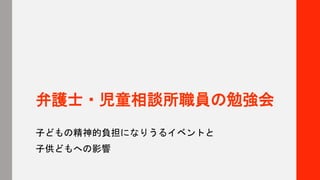子どもの精神的负担になりうるイベント(一时保护関连).辫辫迟虫
- 3. 自分の養育者(父母)と見知らぬ児相職員が 面前口論?暴力に発展する可能性(認知1) ? 参考:親の面前逮捕?収監による子への影響(刑事司法分野の研究) 逮捕の場面では、暴力や警察との口論、武器の使用が伴うこともある(Dallaire & Wilson, 2010) 親の逮捕を目撃することは、子どもにトラウマを与え、混乱させるだけでなく、 警察や権力者に対する憎悪や恐怖に発展する可能性もある(Bernstein, 2005; Kampfner, 1995) ?子どもの前でドンパチやると、トラウマを付与、混乱させる、 警察や権力者に対する憎悪や恐怖を生じさせる、 などのリスクはなくはない 一生忘れない トラウマ
- 4. 自分の養育者(父母)と見知らぬ児相職員が 面前口論?暴力に発展する可能性(認知2) ? 恐怖条件づけ:強い恐怖や不安を引き起こす刺激は、一回でも「恐怖場面に対する 反応」が形成 恐怖刺激(脅威場面)の素早い認識(Masten et al ,2008) と反応(回避?攻撃な ど)は、脅威を回避するのに役立つ可能性???しかし↓ その後のストレス要因に敏感になり,不安やうつ病のリスクを増大させる(Gorka, Hanson, Radtke, & Hariri, 2014 ; Whittle et al ,2011) 恐怖反応の消去にも関与し,心的外傷後ストレス障害(PTSD)の発症に重要な役 割を果たしている可能性(Morey, Haswell, Hooper, & De Bellis, 2016)。 ?つまり、1回の介入がものすごい恐怖体験になったら(認知的に「怖い場面を回 避」が学習され)PTSDに繋がる可能性はある ※恐怖の度合いは虐待介入<IPV(親密なパートナーへの暴力)目撃だと思う ※↑の研究はラットへの電気ショックとか虐待、IPV研究というガチ恐怖体験からの知見 ※そもそも「児相の介入」が恐怖体験として研究対象になってない
- 5. 自分の養育者(父母)と見知らぬ児相職員が 面前口論や面前暴力の可能性(脳) ? IPV( intimate partner violence:親密なパートナーの暴力 ≒DV)目撃の視点 IPVを複数回目撃した場合,左後頭極(視覚情報の一次処理),両側二次視覚野 (V2)の灰白質体積低下(Tomoda, Polcari, Anderson, & Teicher, 2012)と関連が あった。 ※おまけ:小児期の性的虐待を複数回受けた成人では,左右の一次視覚野(V1) および視覚連合野の灰白質体積が減少し,左中後頭回の厚さ等も減少する (Tomoda, Navalta, Polcari, Sadato, & Teicher, 2009)。 ?つまり、1回のIPV目撃で脳への影響とまではいかない そもそも、口論目撃による脳への影響は実証されていない そして児相職員はintimateじゃない(が、犯罪目撃の影響の観点からダメっぽい?) ていうかなんで口論目撃=心理的虐待?根拠不明
- 6. (ちょっと分野は違うけど)親が逮捕されて 結果的に親子分離になった子への影響 ? 親が逮捕された子供の心理学的知見 逮捕された親を持つ子どもは、学校の成績不振、自尊心の低下、内面化問題、反 社会的?非行的行動、その後の逮捕のリスクが高い(Huebner & Gustafson, 2007; Kinner, Alati, Najman, & Williams, 2007; Murray & Farrington, 2008) 家族が警察、裁判所、刑務所に直接関わることは無数にあり、子どものトラウマ を体験する原因になっている (Comfort, 2008) しかし、親の逮捕に関連する多くの要因(薬物乱用、家庭内暴力等)は、児童虐待 のリスク因子でもある(Phillips, Dettlaff, et al, 2010) ?「逮捕の影響」と断言しづらい。
- 7. やっぱ逮捕して加害者分離した方が良い? ? 加害親の分離は(家族にとって有害かつ極度に悪い問題行動を起こした親が収監に より排除された分だけ)家族にプラスの影響をもたらす可能性もある(Jaffee, Moffitt, Caspi, & Taylor, 2003; Sano, 2005) 虐待やネグレクト?暴力を振るう親を禁固刑によって排除することは、被害者で ある家族に有益だが、ほとんどの場合は分離中もつながりを維持することが重 要?(Nesmith & Ruhland, 2008)※サンプル少ない 加害親を逮捕により排除することは、被害者である男児の攻撃性を低下させる (Wildeman, 2010) 反社会的な父親同居している子どもは、「反社会的な父と同居していない同世代 の子ども」と比較して、臨床的に重大な行動問題を起こす可能性がはるかに高い (Jaffee et al., 2003) ?目の前でセンシティブな状況を生じさせてでも、 重大な加害者を分離することで、家族にとってプラスの影響を与える
- 9. 虐待はあったが慣れ親しんだ家や学校(友 人)から離れて一時保護所に連れていかれる ? 参考:パンデミックによる一時隔離の影響(感染疫学分野の研究) ? 一時保護と検疫隔離の心理的共通点:状態の不確実性、移動と活動の制限、愛着 対象や友人との分離、退屈(Brooks et al., 2020) ※親子分離していない隔離ケースを含む 年少の子ども:より不機嫌になったり行動が後退する/年長の子ども:より不安、 怒り、落ち着きがなく、引きこもるようになる。全般的に養育者が反抗的な行動 と解釈するような方法で情緒を表明することも(Imran et al.,2020) 隔離されなかった子どもより適応障害を発症する可能性が高く、PTSDのスコアが 4倍高い(Sprang, & Silman, 2013) 隔離期間と心理的影響の関連性を調べた研究はないが、10日以上など長期間の隔 離者ではPTSDの症状が高いことが示唆(Hawryluck et al., 2004) ?そもそも「先が不確実かつ制限のある隔離」自体が心理的にネガティブな影響
- 10. 知らない場所(一時保護所)に連れて来られ てあれこれプライベートな事を聞かれる ? 二次被害?再トラウマ化の視点 面接が、面接対象者の状態を悪化させる可能性(再トラウマ化=二次被害など) と、エンパワメントや幸福感を促進する可能性の両方を意識することが重要 (Ellison & Munro, 2017; Herman, 2003) ?二次被害を与えない聞き取りを。 二次被害って何が該当?保護所職員は心理担当(or他の心理職)に最初に聞いて
- 11. 知らない場所(保護所)で、①知らない人た ちと集団生活、②ルールに従わせる ① 知らない人との集団生活の心理的影響 警戒状態だと他の作業への取り組みが減少する一方、心理的苦痛(distress)は増加 (Warm et al.,2008) ②恐怖や不安を喚起させた支配(例:怒鳴る、制限を加える、モラハラ) ?心理的虐待による影響などが保護所で子どもに出ます(一次被害) なぜ保護所で虐待的関わりを?:(暴れる子が多い?指導が入らない等により)環境 の安全性を低く感じると、そういう環境への抑止力を期待してダークパーソナリ ティな人(支配的?怖い人)をリーダーに選ぶ傾向(増井?浦,2018) ?集団生活の影響はあると思うが避けようがない 一時保護所での心理的虐待を生まないような構造を!
- 12. 結果まとめ 負の影響があるもの ? 介入がヤバすぎるとPTSD ? 一時保護所の職員にあれこれ聞かれる と二次被害 ? 一時保護所での心理的虐待という一次 被害(ほんとやめて) 負の影響がなさそうなもの ? 1度の介入による脳への影響 負の影響あるけど避けようがないもの ? 慣れ親しんだ環境から一時保護所へ ? 知らない人との集団生活
- 13. 引用文献 Bernstein, N. (2005). All alone in the world: Child- ren of the incarcerated. New York: New Press. Brooks, S. K., Webster, R. K., Smith, L. E., Woodland, L., Wessely, S., Greenberg, N., & Rubin, G. J. (2020). The psychological impact of quarantine and how to reduce it: rapid review of the evidence. The lancet, 395(10227), 912-920. Comfort, M. (2008). Doing time together: Love and family in the shadow of prison. Chicago: University of Chicago Press. Dallaire, D., & Wilson, L. C. (2010). The relation of exposure to parental criminal activity, arrest, and sentencing to children's maladjustment. Journal of Child and Family Studies, 19, 404– 418. Ellison, L., & Munro, V. E. (2017). Taking trauma seriously: Critical reflections on the criminal justice process. The International Journal of Evidence & Proof, 21(3), 183-208. Gorka, A. X., Hanson, J. L., Radtke, S. R., & Hariri, A. R. (2014). Reduced hippocampal and medial prefrontal gray matter mediate the association between reported childhood maltreatment and trait anxiety in adulthood and predict sensitivity to future life stress. Biology of mood & anxiety disorders, 4(1), 1-10. Hawryluck, L., Gold, W. L., Robinson, S., Pogorski, S., Galea, S., & Styra, R. (2004). SARS control and psychological effects of quarantine, Toronto, Canada. Emerging infectious diseases, 10(7), 1206. Herman, J. L. (2003). The mental health of crime victims: Impact of legal intervention. Journal of traumatic stress, 16, 159-166. Huebner, B. M., & Gustafson, R. (2007). The effect to maternal incarceration on adult off-spring involvement in the criminal justice system. Journal of Criminal Justice, 35, 283– 296. Imran, N., Zeshan, M., & Pervaiz, Z. (2020). Mentalhealthconsiderationsforchildren&adolescents in COVID-19 Pandemic. Pakistan Journal of MedicalSciences, 36. Jaffee, S. R., Moffitt, T. E., Caspi, A. & Taylor, A. (2003). Life with (or without) father: The benefits of living with two biological parents depend on the father's antisocial behavior. Child Development, 74, 109– 126. Kampfner, C. J. (1995). Post-traumatic stress reactions in children of imprisoned mothers. In K. Gabel & D. Johnston (Eds.), Children of incarcerated parents (pp. 89– 100). New York: Lexington Books. Kinner, S., Alati, R., Najman, J., & Williams, G. (2007). Do paternal arrest and imprisonment lead to child behavior problems and substance use? A longitudinal analysis. Journal of Child Psychology and Psychiatry, 48, 1148– 1156. 増井啓太、浦光博.(2018).「ダークな」 人たちの適応戦略.心理学評論, 61 (3), 330-343 . Morey, R. A., Haswell, C. C., Hooper, S. R., & De Bellis, M. D. (2016). Amygdala, hippocampus, and ventral medial prefrontal cortex volumes differ in maltreated youth with and without chronic posttraumatic stress disorder. Neuropsychopharmacology, 41(3), 791-801. Murray, J., & Farrington, D. P. (2008). Parental imprisonment: Long-lasting effects on boys' internalizing problems through the life-course. Development and Psychopathology, 20, 273– 290. Nesmith, A., & Ruhland, E. (2008). Children of incarcerated parents: Challenges and resiliency, in their own words. Child and Youth Services Review, 30, 1119– 1130. Phillips, S., Dettlaff, A., & Baldwin, M. (2010). An exploratory study of the range of implications of families' criminal justice system involvement in child welfare cases. Children and Youth Service Review, 32, 544– 550. Sano, Y. (2005). The unanticipated consequences of promoting father involvement: A feminist perspective. In V. Bengston, A. Acock, K. Allen, P. Dilworth-Anderson, & D. Klein (Eds.), Sourcebook of family theory and research (pp. 355– 356). Sprang, G., & Silman, M. (2013). Posttraumatic stress disorder in parents and youth after health-related disasters. Disaster medicine and public health preparedness, 7(1), 105-110. Tomoda, A., Navalta, C. P., Polcari, A., Sadato, N., & Teicher, M. H. (2009). Childhood sexual abuse is associated with reduced gray matter volume in visual cortex of young women. Biological psychiatry, 66(7), 642-648. Tomoda, A., Polcari, A., Anderson, C. M., & Teicher, M. H. (2012). Reduced visual cortex gray matter volume and thickness in young adults who witnessed domestic violence during childhood. PloS one, 7(12), e52528. Warm, J. S., Parasuraman, R., & Matthews, G. (2008). Vigilance requires hard mental work and is stressful. Human factors, 50(3), 433-441. Wildeman, C. (2010). Paternal incarceration and children's physically aggressive behaviors: Evidence from the fragile families and child wellbeing study. Social Forces, 89, 285– 309.












